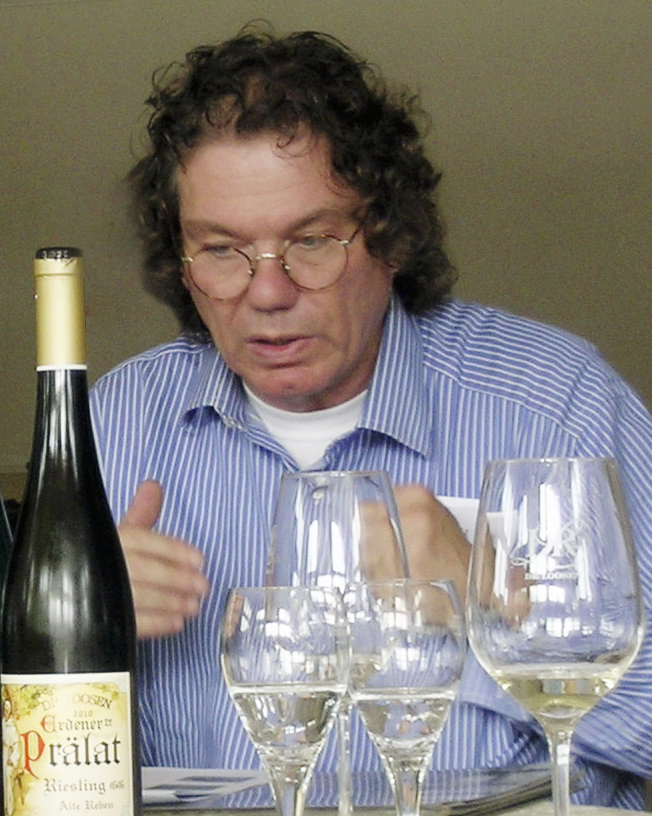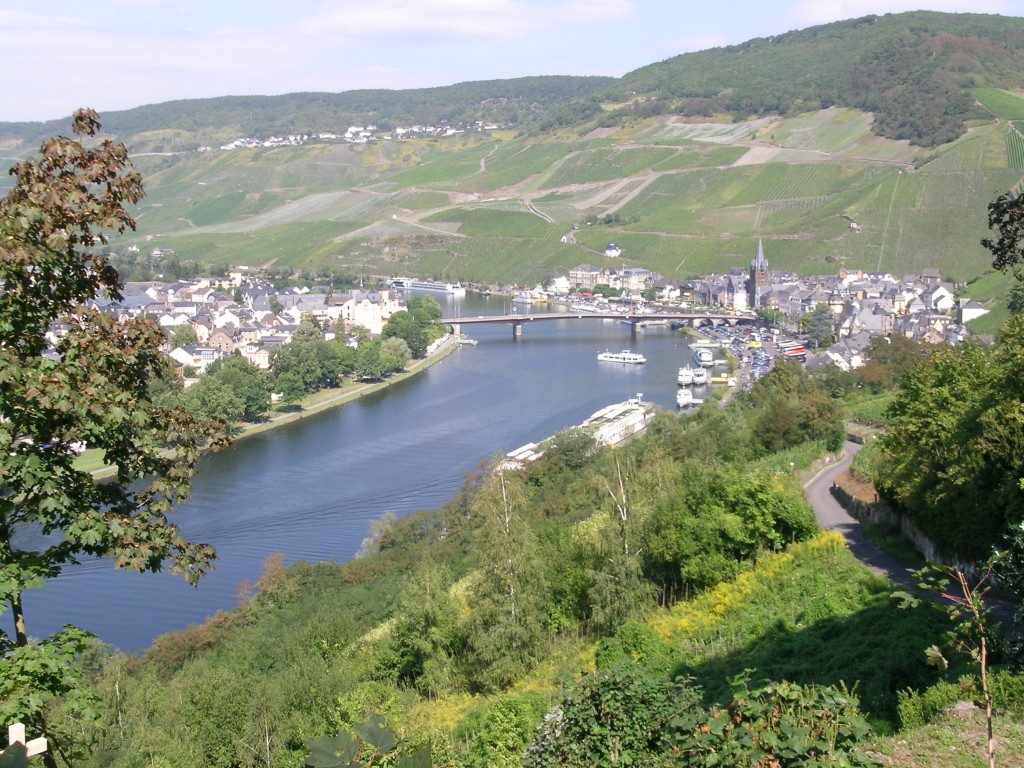
We always want what we don’t have and value the scarcest things most of all. Australian winemakers value acidity – tasting berries anxiously as an ascendant sun pushes sugar levels ever higher as acid levels decline.
In the Mosel, it’s the opposite. There the winemakers value sugar, something Australia produces in abundance. At 50 degrees north only vines on the steepest south, southeast and southwest slopes, like giant solar panels, collect sufficient heat to ripen grapes fully. Acid levels remain high til the end and Germany’s quality system even grades wine according to the sugar content of the grapes.
English writer, Hugh Johnson, likened the impossibly steep slopes to toast held to the fire – though at this latitude the sun’s oblique autumn angle ensures a very slow roast, ensuring the intense but delicate flavours of the area’s unique riesling.
On the right slopes, proven over two millennia, the grapes do, indeed, achieve full sugar and flavour ripeness and retain high acidity. And because of the high humidity, botrytis cinerea flourishes, dehydrating the berries and further concentrating sugar and acidity.
However, not all of the riesling succumbs to botrytis, widening the options available to winemakers – from fresh, fruity dry wines unaffected by botrytis, through delicate, semi-sweet styles, to profound, sticky wonders made only of rotten, shrivelled berries (beerenauslese and trockenbeerenauslese).
After enjoying his wines at a stall in Bernkastel, we visit Heiko Fass, a small maker based at Neumagen-Dhron. A graduate of Geisenheim wine university, Fass took over the old family business from his father and brothers.
He operates the compact cellar single handed, receiving small batches of hand-harvested grapes – picked by the same Polish family that’ve worked for his family for 50 years.
Everything in the steep vineyards is done by hand, he says, meaning Mosel can only ever be about quality, not quantity.
In the cellar we see similarities with mainstream Australian riesling making, but also some notable differences. Like leading Australian makers, Fass transports small batches of grapes quickly to the cellar, separates the juice into free-run and pressings components, settles the juice and ferments it at controlled temperatures in stainless steel tanks, keeping the various components separate until final blending.
A crucial difference, however, is maturing batches of the higher quality rieslings in “fuder”, old oak barrels of about 1,000-litre capacity, used widely in Mosel. Fass also uses a couple of larger 1,800-litre and 2,000-litre oak vessels. He says his father made some of the fuder, including a couple bearing 1965 and 1969 date stamps.
These old vessels allow micro-oxidation, mellowing the wine, muting some of the aromatics and adding texture, without injecting woody flavours.
Upstairs in the living room, overlooking the Mosel, we taste a range of Fass dry, semi-sweet and sweet rieslings from the Hofberger and Roterd vineyards, near Dhron (hence “Dhroner Hofberger” or Dhroner Roterd” on the labels).
What makes riesling sweet or dry? In short, the winemaker – if she wants dry, she ferments all the sugar; if she wants semi-sweet or sweet, she refrigerates the wine, the yeasts quit fermenting and she then filters the yeasts out, just to be sure. So, the sweeter the wine, the lower the alcohol; the drier the wine, the higher the alcohol – all relative, of course, to the amount of sugar in the juice originally.
In the case of the Fass rieslings, the driest wine at an undetectable 3.5 grams of sugar per litre, contained 12.5 per cent alcohol; the half-dry version had 16.8 grams and 11.5 per cent of sugar and alcohol respectively; and the kabinett, spaetlese and auslese at 7–8 per cent alcohol, contained between 48 and 220 grams per litre of sugar.
But because of the high acidity, the 48 grams-of-sugar kabinett remained delicate, clean and refreshing – definitely a three-glass wine; and the truly sticky sweet auslese, though luscious, remained light, buoyant and completely not cloying.
After the tasting we stop in Piesport to see the remains of an old Roman winery – a reminder of the area’s extraordinary winemaking history
If you’re visiting the Mosel, Heiko will gladly show you the cellar and wines by appointment. The visitor centre in Bernkastel has contact details for all Mosel producers.
A short walk out of Bernkastel, we join half a dozen young members of the Oxford University Wine Club for a “tasting and light supper afterwards” at Dr Loosen – one of the Mosel’s most visible, best and outspoken producers. Our host is owner, Ernst (Ernie) Loosen.
Loosen starts with a map of the middle Mosel’s vineyards, compiled in 1868 by the Prussian tax authorities. He says it still holds and became his basis for defining vineyard quality ever since he took over the family business from his father in 1988.
Loosen produces about 40 Mosel wines and takes us through a representative dozen. As we progress he explains, with exasperation, Germany’s confusing wine labelling laws, commenting, “We Germans really hate our customers. We want to make it as difficult as possible”.
Rather than a confusing matrix of regulations for Germany’s different regions, Loosen favours a system that ranks vineyards by their quality, then allows winemakers to choose how they make the wine and whether it’s sweet or dry or in between.
Loosen owns parts of some of the Mosel’s greatest vineyards, including Sonnenuhr, opposite the village of Wehlen; Wurzgarten, just downstream of Urzig; Pralat and Treppchen, opposite the village of Erden; and Lay, adjacent to Bernkastel.
We start with the two dry rieslings, relative newcomers to the portfolio and labelled simply Blue Slate and Red Slate, reflecting the different soils of the vineyards they come from.
But the delicate, sweeter, low alcohol wines from the great vineyards take centre stage. In the warm, sunny sitting room, we linger longer than we ought on the magnificent Wehlener Sonnenuhr Riesling Spaetlese 2010. Then with increasing pleasure we move through the sweeties, culminating in the profound Erdener Pralat Riesling Auslese Goldkapsel 2010 and Bernkastler Lay Riesling Eiswein 2008.
The tasting over, Loosen kicks off the “light supper” with a fresh, taut, bone-dry and delicate sparkling wine, based on a 1990 riesling auslese from the nearby Himmelreich vineyard at Graach.
The tasting finished at around six and we leave the light supper, Loosen and the Oxford mob at around two in the morning. By now we’ve sleuthed our collective our way through 18 mature mystery wines from Switzerland, the USA, South Africa, France, Germany and Australia ¬– the latter represented by the still excellent Coldstream Hills Reserve Yarra Valley Pinot Noir 1992.
The German wines came at the very end, with Loosen’s comment, “Now we will drink ourselves sober on Mosel”. The first, a still lively but mature Erdener Treppchen Riesling Spaetlese 1969, made by his grandfather, could’ve been 20-30 year old we thought, not 42. And the second, introduced as “a refresher”, had been put aside and never sold because of its searing acidity at the time. This was, indeed, a vibrant refresher. We guessed its age as three or four years. In fact, it was an Erdener Treppchen Riesling Spaetlese 1983.
While this demonstrates the staying power of Mosel in a good cellar, the main game for visitors to the region and shoppers in Australia will remain recent vintages. Current selections in Australia go back to 2004, and there are still some of the excellent 2007s around if you look hard.
MOSEL IMPORTERS
This is not a comprehensive list but should, however, lead you to some terrific Mosel rieslings.
Dr Loosen – www.drloosen.de
Imported by Cellarhand, Melbourne (www.cellarhand.com.au). Woolworths, through Dan Murphy, has an exclusive on Dr Loosen Blue Slate Riesling Trocken (dry). We tried and liked the 2010 vintage at Loosen’s cellars, Bernkastel.
Weingut Staffelter Hof
Imported by Canberra’s Lester and Adrienne Jesberg on indent. Winemaker Jan Klein (“one of a young brigade achieving great things”, writes Jesberg) sources fruit from the Letterlay and Steffensberg vineyard. Join the mailing list to hear of future indents by writing to Adrienne at adrjes@bigpond.net.au
Fritz Haag, A. J. Adam, Reinhold Haart, Knebel, Schloss Lieser, Willi Schaefer and Schmitges
Imported by Eurocentric Wines, Sydney (www.eurocentricwine.com.au). The website links to the producer sites.
J. J. Prum
Imported by Bibendum Wine Company, Melbourne (www.bibendum.com.au).
Reichsgraf von Kesselstatt
Imported by Domaine Wine Shippers, Melbourne (www.domainewineshippers.com.au).
Egon Muller
Imported by Negociants Australia (www.necociantsaustralia.com)
Copyright © Chris Shanahan 2011
First published 12 October 2011 in The Canberra Times
